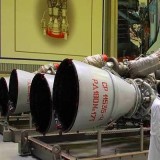Portugal and Brazil to jointly develop a new C-390 Millennium variant for strategic intelligence gathering

{loadposition bannertop}
{loadposition sidebarpub}
On April 1, 2025, during the LAAD Defense & Security exhibition in Rio de Janeiro, the Portuguese Air Force officially announced its decision to join Embraer and the Brazilian Air Force (FAB) in joint studies aimed at adapting the C-390 Millennium multi-mission transport aircraft to perform Intelligence, Surveillance, and Reconnaissance (ISR) missions. The announcement was made at a formal ceremony attended by General João Cartaxo Alves, Commander of the Portuguese Air Force; Lieutenant-Brigadier Marcelo Kanitz Damasceno, Commander of the Brazilian Air Force; Francisco Gomes Neto, President and CEO of Embraer; and Bosco da Costa Junior, President and CEO of Embraer Defense & Security. A concept image was presented showing the roll-on/roll-off modular ISR mission system currently under development. This system is designed to enable ISR capabilities while retaining the aircraft’s existing multi-mission functions.Follow Army Recognition on Google News at this link
The C-390 IVR variant is part of an effort to integrate ISR capabilities into the C-390 such as synthetic aperture radar, electro-optical and infrared sensors, advanced communication systems, and two hardpoints for external payloads. (Picture source: Embraer)
The ISR-capable version of the aircraft is officially designated as the C-390 IVR. This variant is part of an effort led by the Brazilian Air Force and Embraer to integrate ISR capabilities such as synthetic aperture radar, electro-optical and infrared sensors, advanced communication systems, and two hardpoints for external payloads. The development is intended to maintain compatibility with current operational and logistical systems. Structured studies are ongoing to evaluate potential adaptations of the C-390 platform, particularly for maritime patrol and ISR tasks. According to Lieutenant-Brigadier Damasceno, these studies are being conducted efficiently and systematically. Bosco da Costa Junior stated that the initiative is aligned with an ongoing partnership to extend the aircraft’s operational scope.
The announcement by Portugal builds on developments from December 3, 2024, when Embraer and the FAB signed agreements at the Mostra BID National Defense and Security Fair in Brasília to develop ISR and maritime patrol capabilities for the aircraft. These efforts are focused on increasing surveillance coverage across multiple operational environments, including coastal zones and national airspace. The concept of a roll-on/roll-off ISR mission system supports rapid reconfiguration for different missions, including those involving monitoring of territorial waters, Exclusive Economic Zones, and national infrastructure. The Portuguese Air Force’s participation adds operational experience and contributes to technical evaluation processes for the ISR configuration.
The C-390 IVR development aligns with increased global demand for ISR platforms. The ISR aircraft and drones market was valued at $13.37 billion in 2023 and is projected to reach $22.1 billion by 2033. ISR systems are used to monitor large areas for security, environmental, or resource-related purposes. Brazil’s maritime geography and offshore interests are cited as drivers behind the decision to adapt the C-390 to ISR and maritime patrol missions. Similar needs exist in other regions such as Southeast Asia, the Middle East, and Eastern Europe. Countries already operating the C-390 Millennium, including South Korea and Sweden, may assess the ISR variant’s relevance for their maritime or border surveillance requirements.
The C-390 Millennium was developed by Embraer beginning in the mid-2000s with financial support from the Brazilian government and Air Force. It was designed as a twin-engine, jet-powered alternative to turboprop tactical transports such as the C-130. The project received a $1.5 billion development contract in April 2009, and the aircraft’s first flight occurred on February 3, 2015. The aircraft entered service with the Brazilian Air Force in 2019. By June 2022, the C-390 fleet had flown over 8,200 hours across 6,000 flights. According to Embraer and the FAB, the platform achieved a technical availability rate of approximately 80% and a mission completion rate of 99.5%. The aircraft has been used in various missions, including pandemic response in Manaus, humanitarian aid to Lebanon and Haiti, joint exercises in the United States, Antarctic supply flights, and repatriation efforts during the Russia–Ukraine conflict.
Portugal has been part of the C-390 program since 2010. It ordered five aircraft in 2019 to replace its C-130 fleet. The first C-390 was delivered in October 2022, reached full operational status in October 2023, and has since completed transatlantic missions and international exercises. Portugal’s OGMA company is involved in the industrial production of the aircraft, including structural components and systems. On April 25, 2023, Brazilian President Luiz Inácio Lula da Silva and Portuguese Prime Minister António Costa announced that the KC-390 could be assembled at OGMA for European customers. The Portuguese Air Force’s involvement in ISR studies reflects its existing operational use of the aircraft and participation in the industrial base.
The C-390 Millennium has been ordered by ten air forces. Brazil originally ordered 28 aircraft in 2014, later revised to 22 in 2022. Portugal ordered five units, Hungary ordered two (with the first delivered in April 2024 in a medical configuration), and the Netherlands ordered five to replace its C-130H fleet. Austria ordered four, with deliveries planned between 2027 and 2030. The Czech Republic signed a contract in October 2024 for two units. South Korea selected three aircraft in 2023, to be introduced by 2026. Sweden ordered four aircraft in 2024. Slovakia selected the C-390 in December 2024 and began negotiations for three aircraft. An undisclosed customer also selected the platform. Morocco received one aircraft for evaluation. Discussions are ongoing with India, Egypt, South Africa, Colombia, Rwanda, Greece, Angola, and Saudi Arabia. Embraer and BAE Systems have signed agreements to market the aircraft to Gulf countries, and Embraer signed MoUs with Mahindra Group in India for potential local assembly. Correios, Brazil’s postal service, signed an MoU with Embraer in 2024 to assess the C-390’s suitability for civilian air cargo transport.
The C-390 Millennium is a medium-sized, twin-engine, jet-powered military transport aircraft. It is capable of transporting up to 26 tonnes of cargo or equipment, including two M113 armored personnel carriers, one Boxer armored vehicle, a Sikorsky H-60 helicopter, 74 litters with life-support equipment, 80 soldiers, or 66 paratroopers with full gear. It supports aerial refueling operations using two Cobham wing-mounted probe and drogue pods. The aircraft has a cruise speed of Mach 0.8, a maximum speed of 988 km/h, and a maximum payload range of up to 2,000 kilometers. Its ferry range can extend to 8,460 kilometers with auxiliary tanks. It features fly-by-wire flight controls, Rockwell Collins Pro Line Fusion avionics, directional infrared countermeasures, and a continuously computed drop point system.
The cargo hold measures 18.5 meters in length, 3.45 meters in width, and 2.95 meters in height. The aircraft includes systems for container and low-velocity airdrop delivery, and features such as a galley, accessible toilet, noise and vibration reduction, and automatic temperature control. The modular configuration allows the aircraft to be reconfigured for troop transport, medical evacuation, air-to-air refueling, cargo, firefighting, and ISR missions. Its structure is compatible with unpaved or damaged runways. Key subcontractors include OGMA, Aero Vodochody, Rockwell Collins, BAE Systems, and Fábrica Argentina de Aviones. The aircraft is powered by two IAE V2500-E5 turbofan engines producing 139.4 kN each. As of 2024, the estimated unit cost of the C-390 is approximately €80 million.

{loadposition bannertop}
{loadposition sidebarpub}
On April 1, 2025, during the LAAD Defense & Security exhibition in Rio de Janeiro, the Portuguese Air Force officially announced its decision to join Embraer and the Brazilian Air Force (FAB) in joint studies aimed at adapting the C-390 Millennium multi-mission transport aircraft to perform Intelligence, Surveillance, and Reconnaissance (ISR) missions. The announcement was made at a formal ceremony attended by General João Cartaxo Alves, Commander of the Portuguese Air Force; Lieutenant-Brigadier Marcelo Kanitz Damasceno, Commander of the Brazilian Air Force; Francisco Gomes Neto, President and CEO of Embraer; and Bosco da Costa Junior, President and CEO of Embraer Defense & Security. A concept image was presented showing the roll-on/roll-off modular ISR mission system currently under development. This system is designed to enable ISR capabilities while retaining the aircraft’s existing multi-mission functions.
Follow Army Recognition on Google News at this link
The C-390 IVR variant is part of an effort to integrate ISR capabilities into the C-390 such as synthetic aperture radar, electro-optical and infrared sensors, advanced communication systems, and two hardpoints for external payloads. (Picture source: Embraer)
The ISR-capable version of the aircraft is officially designated as the C-390 IVR. This variant is part of an effort led by the Brazilian Air Force and Embraer to integrate ISR capabilities such as synthetic aperture radar, electro-optical and infrared sensors, advanced communication systems, and two hardpoints for external payloads. The development is intended to maintain compatibility with current operational and logistical systems. Structured studies are ongoing to evaluate potential adaptations of the C-390 platform, particularly for maritime patrol and ISR tasks. According to Lieutenant-Brigadier Damasceno, these studies are being conducted efficiently and systematically. Bosco da Costa Junior stated that the initiative is aligned with an ongoing partnership to extend the aircraft’s operational scope.
The announcement by Portugal builds on developments from December 3, 2024, when Embraer and the FAB signed agreements at the Mostra BID National Defense and Security Fair in Brasília to develop ISR and maritime patrol capabilities for the aircraft. These efforts are focused on increasing surveillance coverage across multiple operational environments, including coastal zones and national airspace. The concept of a roll-on/roll-off ISR mission system supports rapid reconfiguration for different missions, including those involving monitoring of territorial waters, Exclusive Economic Zones, and national infrastructure. The Portuguese Air Force’s participation adds operational experience and contributes to technical evaluation processes for the ISR configuration.
The C-390 IVR development aligns with increased global demand for ISR platforms. The ISR aircraft and drones market was valued at $13.37 billion in 2023 and is projected to reach $22.1 billion by 2033. ISR systems are used to monitor large areas for security, environmental, or resource-related purposes. Brazil’s maritime geography and offshore interests are cited as drivers behind the decision to adapt the C-390 to ISR and maritime patrol missions. Similar needs exist in other regions such as Southeast Asia, the Middle East, and Eastern Europe. Countries already operating the C-390 Millennium, including South Korea and Sweden, may assess the ISR variant’s relevance for their maritime or border surveillance requirements.
The C-390 Millennium was developed by Embraer beginning in the mid-2000s with financial support from the Brazilian government and Air Force. It was designed as a twin-engine, jet-powered alternative to turboprop tactical transports such as the C-130. The project received a $1.5 billion development contract in April 2009, and the aircraft’s first flight occurred on February 3, 2015. The aircraft entered service with the Brazilian Air Force in 2019. By June 2022, the C-390 fleet had flown over 8,200 hours across 6,000 flights. According to Embraer and the FAB, the platform achieved a technical availability rate of approximately 80% and a mission completion rate of 99.5%. The aircraft has been used in various missions, including pandemic response in Manaus, humanitarian aid to Lebanon and Haiti, joint exercises in the United States, Antarctic supply flights, and repatriation efforts during the Russia–Ukraine conflict.
Portugal has been part of the C-390 program since 2010. It ordered five aircraft in 2019 to replace its C-130 fleet. The first C-390 was delivered in October 2022, reached full operational status in October 2023, and has since completed transatlantic missions and international exercises. Portugal’s OGMA company is involved in the industrial production of the aircraft, including structural components and systems. On April 25, 2023, Brazilian President Luiz Inácio Lula da Silva and Portuguese Prime Minister António Costa announced that the KC-390 could be assembled at OGMA for European customers. The Portuguese Air Force’s involvement in ISR studies reflects its existing operational use of the aircraft and participation in the industrial base.
The C-390 Millennium has been ordered by ten air forces. Brazil originally ordered 28 aircraft in 2014, later revised to 22 in 2022. Portugal ordered five units, Hungary ordered two (with the first delivered in April 2024 in a medical configuration), and the Netherlands ordered five to replace its C-130H fleet. Austria ordered four, with deliveries planned between 2027 and 2030. The Czech Republic signed a contract in October 2024 for two units. South Korea selected three aircraft in 2023, to be introduced by 2026. Sweden ordered four aircraft in 2024. Slovakia selected the C-390 in December 2024 and began negotiations for three aircraft. An undisclosed customer also selected the platform. Morocco received one aircraft for evaluation. Discussions are ongoing with India, Egypt, South Africa, Colombia, Rwanda, Greece, Angola, and Saudi Arabia. Embraer and BAE Systems have signed agreements to market the aircraft to Gulf countries, and Embraer signed MoUs with Mahindra Group in India for potential local assembly. Correios, Brazil’s postal service, signed an MoU with Embraer in 2024 to assess the C-390’s suitability for civilian air cargo transport.
The C-390 Millennium is a medium-sized, twin-engine, jet-powered military transport aircraft. It is capable of transporting up to 26 tonnes of cargo or equipment, including two M113 armored personnel carriers, one Boxer armored vehicle, a Sikorsky H-60 helicopter, 74 litters with life-support equipment, 80 soldiers, or 66 paratroopers with full gear. It supports aerial refueling operations using two Cobham wing-mounted probe and drogue pods. The aircraft has a cruise speed of Mach 0.8, a maximum speed of 988 km/h, and a maximum payload range of up to 2,000 kilometers. Its ferry range can extend to 8,460 kilometers with auxiliary tanks. It features fly-by-wire flight controls, Rockwell Collins Pro Line Fusion avionics, directional infrared countermeasures, and a continuously computed drop point system.
The cargo hold measures 18.5 meters in length, 3.45 meters in width, and 2.95 meters in height. The aircraft includes systems for container and low-velocity airdrop delivery, and features such as a galley, accessible toilet, noise and vibration reduction, and automatic temperature control. The modular configuration allows the aircraft to be reconfigured for troop transport, medical evacuation, air-to-air refueling, cargo, firefighting, and ISR missions. Its structure is compatible with unpaved or damaged runways. Key subcontractors include OGMA, Aero Vodochody, Rockwell Collins, BAE Systems, and Fábrica Argentina de Aviones. The aircraft is powered by two IAE V2500-E5 turbofan engines producing 139.4 kN each. As of 2024, the estimated unit cost of the C-390 is approximately €80 million.




